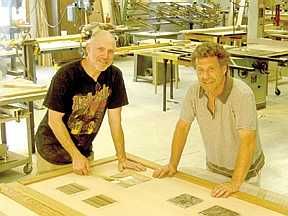Collared once with the label “man of the cloth”
for his intricate fabric collages,
fifty-few-year-old local galleryist Joel Fremion
remains today an enthusiastic and dedicated
proselytizer for homegrown talent.
“It has always been a disturbing part of the
area art scene that collectors have historically
placed an emphasis on work, whether in the fine
arts or crafts, created outside Fort Wayne,” he
says to anyone listening. “It is as though they
relate value and quality solely on the basis of
its being ‘imported’ rather than locally
created.
“That’s one of my main themes now – in-sourcing, not outsourcing talent.”
“While he doesn’t hold the exclusive patent on
that idea, the articulate and talented
artist/entrepreneur has demonstrated a two-decade
long history of championing local artists and
artisans first in 1987 with his Old House
Galleries in Lakeside and now, begun in 2004,
with his Indiana for Modern complex in
Uniondale.
Reclaimed from what may have been an auto
dealership on the main street of this tiny
northern Wells County hamlet off of State Road
224 Fremion, together with partner Raymond New
and collaborators Bill Lupkin and Richard Tuck,
have created a gallery and studio workshop the
likes of which have never before been seen in
these parts.
This foursome, each with well-established
reputations in their separate areas, has combined
to form a consortium of talent that mimics a
guild of craftsmanship that harkens back to other
times and places. Tuck (the much collected and
celebrated stoneware sculptor), Lupkin (whose
leaded stained glass and mosaic installations
adorn numerous regional churches) and New (a
master woodworker), together with Fremion, have
embarked on a journey to fabricate unique
elements of interior/exterior handcrafted
furniture.
Initially inspired by the look of the furniture
made popular by the Dunbar Company of Berne in
the 20 years following the WWII, Fremion and his
associates have dedicated themselves to the
revival of this modernist style, a style that is
both contemporary (think Scandinavian) and yet
imbues a kind of timelessness of quality (think
Shaker).
In the case of their room screens or dividers,
the group uses exotic woods to fashion inlaid
veneer designs, and they incorporate sculpted
ceramic elements along with epoxy resin “windows”
and rich, molten glass panels. The pieces also
contain suede and fabric collages and the results
are not only unique but resonate with quality and
craftsmanship.
The small side or end tables make use of special
rare woods, and some are topped with hand-blown
and molded art glass and pottery inserts. Brass,
aluminum and stainless steel, as with the
original Dunbar, are used as accents.
“Our intention is to reinterpret and reproduce
the 50s modern era classic designs,” Fremion
states. “We believe we can better some of the
designs by the incorporation of exotic woods,
ceramic and glass mosaic tops and technical
advances not available 50 years ago. We feel,
because of the rarity of many of these designs,
that we will be able to market our designs to the
vintage market as well as to the developing retro
market.”
The Arts and Crafts Indiana for Modern building
with a 6,000-square-foot workshop and assembly
area together with an adjoining two-story gallery
and showroom was actually opened with a
thoroughly wonderful show in early May. The
exhibition features works from the “Jewelry for
the Home” collection of accessory tables and room
screens along with works from artists George
McCullough, Norman Bradley, David Krouse and
Russell Oettel in addition to pieces by Fremion,
Lupkin and Tuck. The show is still up and is well
worth the half-hour drive. (See
www.indianamodern.com for more info).
Fremion’s path to the creation of Indiana for
Modern actually began at the old Fort Wayne Art
Institute where he studied art history, painting,
design and metalsmithing under instructors like
McCullough, Bradley and Oettel. From there he
went on to study at the former Purdue University
DIGITS campus where he pursued work in contract
and residential interior and architectural
design.
At one point he apprenticed with the former
local architect and painter Dale Amburn.
Most ironically, about 10 years ago he and his
wife Nancy purchased a house in Ossian only to
learn later, after perusing the structure’s
blueprints, that it was designed by his mentor
Amburn.
The home serves as a most suitable showcase for
Fremion’s vast collection of not only Dunbar
furnishings but a formidable library related to
all things Dunbar, including materials related to
Dunbar designers Edward Wormley and Roger Lee
Sprunger. Some day Fremion hopes to produce a
definitive book on the two designers and the
Dunbar legacy.
That’s a project that may have to wait a bit as
his time is consumed with commissioned work
through Indiana for Modern.
Oh yeah, then there are all those who think you
can’t be a hero in your own hometown, just ripe
for conversion.
 Submit Your Event
Submit Your Event
